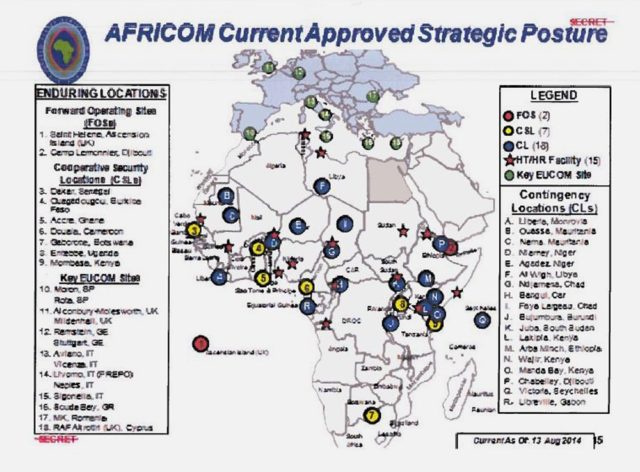Above Photo: From Fair.org

The New York Times (3/31/19) added to its series of reports depicting Official Enemies surpassing the US in the race for global dominance. It seems that having taken control of the Arctic (FAIR.org, 9/15/15), the nuclear domain (FAIR.org, 3/7/18) and a whole host of other spaces the US is “behind” in, Russia is now gobbling up Africa—a threat the US, presumably, must counter with an even greater military build-up.
The report, “Russia’s Military Mission Creep Advances to a New Front: Africa,” by Eric Schmitt, asserting an uptick in Russian weapons contracts and military training exercises in Africa, is thin on context and hard numbers, but is artificially fortified with a series of anecdotes and frightening quotes. Since the obvious rejoinder to any discussion of increased Russian presence in Africa is, “OK, but what is the US’s current reach?” the Times hangs a lampshade on the inconvenience with this throwaway line:
The United States military has a relatively light footprint across Africa.
About 6,000 United States troops and 1,000 Defense Department civilians or contractors work on a variety of missions throughout Africa, mainly training and conducting exercises with local armies.
According to documents obtained by the Intercept’s Nick Turse (12/1/18), the US currently has 34 military bases in Africa; Russia has zero. The Times doesn’t tell us how many “contractors’ and “troops” Russia has in Africa, so it’s not clear what the so-called “light footprint” is “relative” to. Is it 10? 100? 10,000? If it’s a lot less than 6,000, then the story is a bit of a dud. Alas, we’re simply left guessing at the “relative” size of Russia’s Africa presence.

AFRICOM Will Maintain Light Footprint in Africa — The United States has no plans to seek permanent bases in Africa, and, in the spirit of the new defense strategic guidance, will continue to maintain a “light footprint” on the continent, the top US Africa Command officer said.Also worth noting: “Light footprint” is the same Orwellian phrase the Pentagon has been using for years to obscure the growth of AFRICOM, as in this AFRICOM press release (6/13/12) :
It’s always reassuring when the paper of record adopts the US government’s preferred press release language. (See also New York Times, 1/25/12 , 3/1/19.)
Aside from quotes from US military brass, Schmitt’s report was primarily propped up with testimony from weapons contractor-funded think tanks, namely the Institute for the Study of War and the Center for International and Strategic Studies, which both provided urgent, stakes-raising narratives:
Russia is seeking more strategic bases for its troops, including at Libyan ports on the Mediterranean Sea and at naval logistics centers in Eritrea and Sudan on the Red Sea, according to an analysis by the Institute for the Study of War, a research organization in Washington….
“Moscow and its private military contractors are arming some of the region’s weakest governments and backing the continent’s autocratic rulers,” said Judd Devermont, director of the Africa Program at the Center for Strategic and International Studies in Washington. “This engagement threatens to exacerbate current conflict zones.”
Panic over a creeping Russia menace in Africa is timed, not coincidentally, with congressional debate over the Defense budget, submitted by Trump two weeks ago. In addition, some congressional Democrats and Republicans are working to erode what little caps exists for the military budget, with a planned vote next week in the House for lifting limits on discretionary Defense spending.
Needless to say, the primary funders of the Center for Strategic and International Studies and Institute for Study of War—the think tanks whose juicy quotes and studies bolster the primary arguments of the articles’ premise—stand to make tens of billions in profit from both of these legislative efforts. Having the New York Times provide marketing collateral for these efforts is no doubt useful in convincing an increasingly war-weary public, and accordingly war-wary Congress, to rubberstamp yet another record-setting Pentagon budget.
For hawkish arms industry-funded groups like CSIS, the answer is always to build more weapons systems and to paint enemy states in the most sinister light possible. One 2017 study by FAIR (5/8/17) found that while commenting on Korea, CSIS’s experts either explicitly backed its funder Lockheed Martin’s THAAD weapons system, or its central value proposition that it would ward off a hostile North Korea, 30 out of 30 times. There were zero examples of a CSIS rep downplaying a threat or arguing against more military spending. When asked in email to provide an example of CSIS saying any threat was exaggerated or advising against any kind of military spending increase, the CSIS spokesperson declined to comment.
The primary purpose of organizations like CSIS and ISW is to push the weapons systems of the corporations that fund them. Any analysis of their reports, studies or media appearances will show that at least 99 percent of the time, they come down on the side of hyping threats and pushing for the shiny new publicly funded instruments that would counter those threats.

“As a think tank, the Center for Strategic and International Studies did not file a lobbying report,” Eric Lipton and Brooke Williams reported, “but the goals of the effort were clear.”This glaring conflict of interest, as usual, isn’t disclosed by the New York Times. A particularly strange omission, since it was the Times itself in 2016 that, citing leaked emails, argued (8/7/16) that CSIS was acting as a thinly veiled lobbyist for its weapons-maker funder General Atomics, and was, according to its own report, “blurring the line between researchers and lobbyists.”
They are clear indeed. Yet since that time, CSIS has continued to be the go-to source for analyzing global threats for the Times, without even a token disclosure.
Also as usual, the article went to no skeptical voices for any comment; the only sources sought were war makers and those funded by war makers. They all worked to paint a one-sided, cartoon picture of a Russian takeover of Africa, complete with the patented New York Times double standard of motives: Russia is said by Schmitt to be seeking “new economic markets and energy resources.” The United States? Simply there to provide “foreign aid” and “train and conduct exercises with local armies.” In the Times, the idea that the US would also be motivated by securing markets and resources would be tantamount to lizard people conspiracy theory talk. But for Russia, it’s simply taken for granted.
In the Times, Official Enemy threats are unquestionably bad, and unquestionably sinister in nature. The only answer? Let the Pentagon gravy train run its course, year in and year out, because invariably there will always be, with the help of the New York Times, the specter of an enemy threat “advancing on a new front.”


